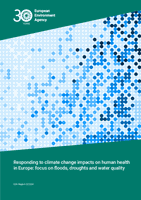
The EU's long-term transition to environmental, social and economic sustainability
runs alongside several large-scale crises. Amidst the 'triple crisis' of climate
change, biodiversity loss and the impact of environmental pollution on human
health (UNEP, 2020), we also face crises in the political, economic and social spheres,
including the wars in Ukraine and the Middle East, the 'slowbalisation' of the global
economy and trade (European Parliament, 2020) and growing societal fragmentation
over values and identities.

This report aims to raise awareness about the range of risks to human health
associated with changes in water quantity and quality under the changing climate. It
assesses our preparedness for ongoing and future impacts by examining the current
policy landscape in Europe. At the same time, it seeks to inspire action by showing
examples of practical measures implemented across various sectors and on various
scales in the EEA member and collaborating countries.

Average temperatures across Europe are rising faster than the global average, and Europe's cities are feeling the impacts of climate change more regularly and more severely. With the summer of 2023 breaking temperature records, the case for investing in societal resilience to climate change has never been clearer.

The first European Climate Risk Assessment (EUCRA) identifies 36 climate risks that pose a threat to Europe’s energy and food security, ecosystems, infrastructure, water resources, financial stability, and people’s health. It shows that many of these risks have already reached critical levels and can become catastrophic without urgent and decisive action. The knowledge in this first-of-its-kind assessment is synthesised to support strategic policymaking.

Monitoring report on progress towards the 8th EAP objectives
2023 edition

This report looks at how biomass can help us reach our climate and environmental objectives, and how climate change might affect the EU's biomass production in agriculture and forest sectors. It also discusses key synergies and trade-offs in the use of biomass for different policy objectives.

This report explores the historical trends, most recent progress and projected future
progress on climate change mitigation through reduced GHG emissions, renewable
energy gains and improved energy efficiency. It builds upon data reported by the
EU-27 Member States, five EEA member countries and nine Contracting Parties of the
Energy Community.

The EEA′s annual environmental statement report for 2022 conforms to requirements
stipulated in the EU Eco-Management and Audit Scheme (EMAS) Regulation and
takes into account the sectoral reference document for the public administration
sector. The report contains information on the EEA′s environmental management
system (EMS), its environmental performance in the year 2022, and the updated
environmental targets and an action plan for 2023.

The European Environment Information and Observation Network (Eionet) is a partnership network of the EEA and its member and cooperating countries. This briefing presents the results of data collected in 2022 for 13 Eionet core data flows. It summarises the evaluation of hundreds of data deliveries received from reporting countries. The purpose of the briefing is to show progress against agreed reporting criteria (timeliness and data quality), allowing countries to identify and prioritise the resources they need for regular reporting procedures. The provision of high-quality data by Eionet is fundamental for the EEA to achieve its mission to provide timely, targeted, relevant and reliable information to policy-making agents and the public.

Submission under the United Nations Framework Convention on Climate Change

Advancing towards climate resilience in Europe: status of reported national adaptation actions in 2021

This report explores the historical trends, most recent progress and projected future paths towards mitigating climate change through reduced greenhouse gas emissions, renewable energy gains and improved energy efficiency. It builds on data reported by the 27 EU Member States (EU-27), Iceland and Norway.

Renewable technologies create new opportunities for citizens to become energy producers themselves and to actively contribute to the energy transition. This report provides an overview of the role of renewable energy prosumers in Europe, including case studies on successful initiatives.

Decarbonising road transport — the role of
vehicles, fuels and transport demand

Annual European Union greenhouse gas
inventory 1990–2020 and inventory report 2022
Submission to the UNFCCC Secretariat

Creating a resilient economy within environmental limits

For climate change mitigation policies to be successful in reducing greenhouse gas emissions their potential social implications need to be considered and addressed. Together with multiple-level governance coordination and societal participation, these are the key success factors to achieve win-win social-climate policies, minimise the unfair impacts of carbon and energy taxes, and maximise environmental and health benefits.

The year 2020 saw remarkable progress towards meeting the EU's climate and energy targets. Rarely in the publication of the annual Trends and projections in Europe report has this executive summary presented such substantial progress as this edition does. Preliminary estimates indicate that, in 2020, we witnessed the full achievement — and even overachievement — of Europe's 20-20-20 goals for climate change mitigation, renewable energy deployment and energy efficiency gains. This keeps Europe well on track in its journey towards climate neutrality by mid-century.

The extraction and processing of raw materials are associated with potentially significant environmental impacts, including contributing to approximately half of the greenhouse gas (GHG) emissions globally. In the EU, non-energy, non-agricultural raw materials, although a small subset of all raw materials and natural resources, account for 18 % of GHG emissions
associated with EU consumption. In the context of the EU's commitment to reducing its share of global GHG emissions, as well as the European Green Deal's aspiration to achieve a climate-neutral continent by 2050, mitigating climate impacts from raw material production has a central role to play in the EU's climate agenda.

Submission under the United Nations Framework Convention on Climate Change and the Kyoto Protocol
Document Actions
Share with others